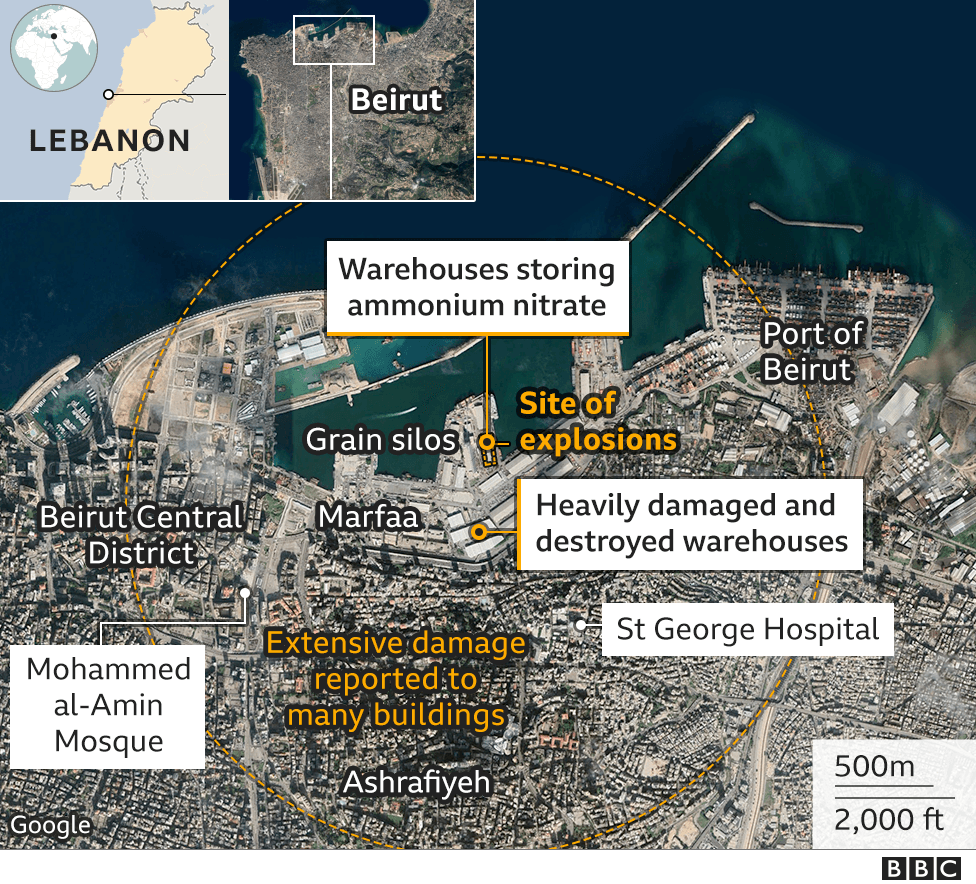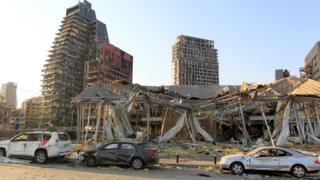
Rescue workers in Lebanon have been digging through the rubble looking for survivors of a devastating explosion in Beirut on Tuesday that killed at least 135 people and injured more than 5,000 others.
Here is what we know so far.
What happened?
There was reportedly an initial explosion in the port area around about 18:00 (15:00 GMT) followed by a fire and small blasts that some witnesses said sounded like fireworks going off.
Videos posted on social media showed white smoke billowing from a warehouse next to the port's grain silos shortly before a colossal explosion sent a fireball into the air and generated a supersonic, mushroom cloud-shaped shockwave that radiated across the city.

Media playback is unsupported on your device
That second blast levelled buildings near the port and caused extensive damage over much of the rest of the capital, which is home to two million people. Hospitals were quickly overwhelmed.
"What we are witnessing is a huge catastrophe," said the head of the Lebanese Red Cross, George Kettani. "There are victims and casualties everywhere."
Beirut Governor Marwan Abboud said as many as 300,000 people had been made temporarily homeless and that the collective losses might reach $10-15bn (£8-11bn).

How big was the blast?
Experts have not yet determined its size, but the shockwave blew out windows at Beirut International Airport's passenger terminal, about 9km (5 miles) away from the port.
The explosion was also heard as far away as Cyprus, about 200km (125 miles) across the Mediterranean Sea, and seismologists at the United States Geological Survey said it was the equivalent of a 3.3-magnitude earthquake.
Interactive See extent of damage at Beirut blast site
5 August 2020

25 January 2020

What was the cause?
Lebanon's President, Michel Aoun, blamed the detonation of 2,750 tonnes of ammonium nitrate that he said had been stored unsafely at a warehouse in the port.
A similar amount of the chemical arrived on a Moldovan-flagged cargo ship, the MV Rhosus, which docked in Beirut in 2013 after suffering technical problems while sailing from Georgia to Mozambique.
The Rhosus was inspected, banned from leaving and was shortly afterwards abandoned by its owners, according to industry newsletter Shiparrested.com. Its cargo was reportedly moved to a port warehouse for safety reasons, and should have been disposed of or resold.
More on the explosion in Beirut
Ammonium nitrate is a crystal-like white solid commonly used as a source of nitrogen for agricultural fertiliser. But it can also be combined with fuel oils to create an explosive used in the mining and construction industries. Militants have made bombs with it in the past.
 Image copyright
EPA
Image caption
There is now a huge crater where the warehouse storing the ammonium nitrate once stood
Image copyright
EPA
Image caption
There is now a huge crater where the warehouse storing the ammonium nitrate once stood
Experts say that ammonium nitrate is relatively safe when stored properly. However, if you have a large amount of material lying around for a long time it begins to decay.
"The real problem is that over time it will absorb little bits of moisture and it eventually turns into an enormous rock," Andrea Sella, professor of chemistry at University College London, told the BBC. This makes it more dangerous because if a fire reaches it, the chemical reaction will be much more intense.
Ammonium nitrate has been associated with deadly industrial accidents. In 1947, a ship carrying 2,000 tonnes of the chemical exploded in Texas, killing 581 people.
Who is to blame?
President Aoun promised a transparent investigation into the blast.
"We are determined to go ahead with an investigation and unveil the circumstances surrounding what happened as soon as possible and hold those responsible and those who were negligent accountable and serve them the most severe punishment," he said on Wednesday after visiting the ruined port.

Prime Minister Hassan Diab described the circumstances that led to the explosion as "unacceptable".
The port's general manager, Hassan Koraytem, and the director general of Lebanese Customs, Badri Daher, said their warnings about the danger posed by the stored ammonium nitrate and calls for it to be removed were repeatedly ignored.
"We requested that it be re-exported but that did not happen. We leave it to the experts and those concerned to determine why," Mr Daher told broadcaster LBCI.
 Image copyright
Reuters
Image caption
Lebanese President Michel Aoun vowed to hold those responsible to account
Image copyright
Reuters
Image caption
Lebanese President Michel Aoun vowed to hold those responsible to account
Documents circulated online appeared to show that customs officials sent letters to the judiciary seeking guidance at least six times from 2014 to 2017.
The government has ordered officials at the port who oversaw the storage of the ammonium nitrate to be put under house arrest pending the completion of the investigation.
.

 5 years ago
619
5 years ago
619 

